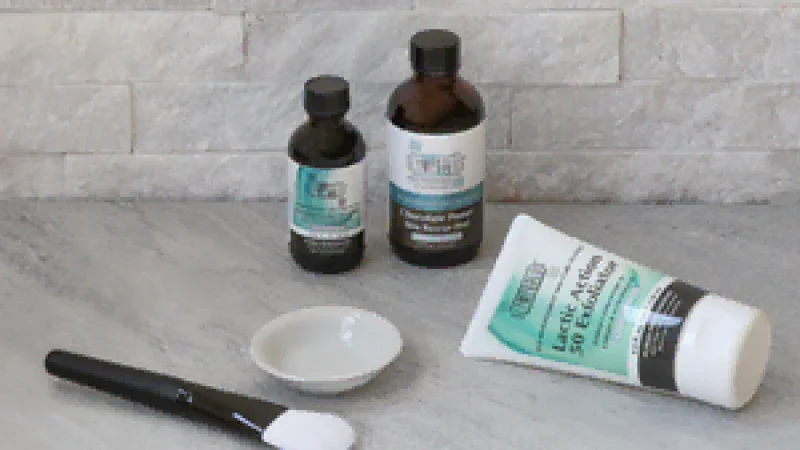Lactic acid is an alpha hydroxy acid (AHA), used in over-the-counter (OTC) skin care products and professional treatments. Lactic acid is used to remove dead skin cells, lighten dark spots, and improve the look of fine lines and wrinkles.
Lactic acid is one of the most popular alpha hydroxy acids available. It is a common ingredient in OTC skin care products. It is also used in stronger professional peels and treatments.
Lactic acid is naturally found in dairy products. It’s what gives yogurt and soured milk that distinctive tang. Dairy products have actually been used by people across the world to soften and beautify the skin. People still take milk baths, but most lactic acid used in skin care products and peels is synthetic (produced in a laboratory). Topical treatments to treat eczema, psoriasis, and rosacea often contain lactic acid.
Benefits of Lactic Acid for the Skin
- Lactic acid helps remove old, dull cells on the skin’s surface by dissolving the bonds that hold them together. This process is called exfoliation.
- Lactic acid speeds up cell turnover and stimulates cell renewal—the processes by which your skin sheds old cells and replaces them with new ones. As a result, it gives you a brighter complexion, as well as smoother and softer skin.
- Lactic acid creates a real change in the skin if used regularly.
- It’s one of the more gentle hydroxy acids used in skin care. It helps improve the skin’s natural moisture factor, or the way the skin keeps itself hydrated. Lactic acid helps to keep the skin moisturized and feeling less dry.
- When you use lactic acid regularly, it can also improve signs of aging. It does so by stimulating the renewal of collagen, a fiber that helps keep the skin firm.
- Lactic acid can help fade sun spots or age spots and can smoothen and soften fine lines and wrinkles.
Possible Side Effects of Lactic Acid on the Skin
Though lactic acid is gentler than other AHAs, it is still a strong treatment. Possible side effects when using lactic acid include:
Sun Sensitivity
The most important thing you need to know before you start using lactic acid is that it can make your skin more sensitive to the sun. As the acid sloughs away skin cells, it leaves your skin more likely to be damaged by ultraviolet light.
Use SPF 30 or higher sunscreen daily to protect your skin from sunburn and sun damage, even on cloudy days. If you don’t, you could “undo” the benefits of lactic acid, like its ability to fade spots and soften wrinkles.
Skin Irritation
Lactic acid can also cause skin irritation. Be on the lookout for redness, burning, peeling, dryness, itchy skin and swelling. Minor redness, burning, and itching can occur when you first apply a lactic acid product. As long as it is mild and goes away within an hour or so, it’s nothing to worry about.
If the redness, burning, and itching is moderate to severe or doesn’t go away after a short period of time, or if you have swelling or a rash, wash the product off right away. Don’t use it again and call your healthcare provider for advice.
Lactic acid is the gentlest of the alpha hydroxy acids, so most people can use it without any problem. Still, some people should not use products with lactic acid.
If you have very sensitive skin, lactic acid can irritate your skin. Start with using a product with a small percentage of lactic acid and see how your skin reacts. If you notice any irritation, stop using the product.
If you use products that contain retinol, these products are already exfoliating your skin. If you also use a product with lactic acid, your skin could become too sensitive.
If you are using any prescription skin care medication, check with your healthcare provider before using any lactic acid treatment. It may not be appropriate for your skin.

